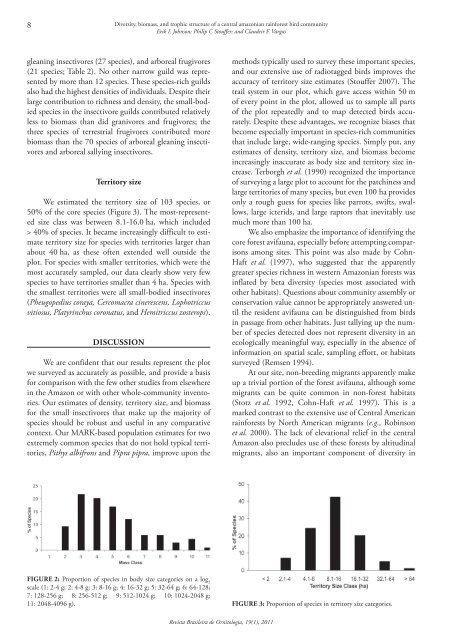Capa 19(1) - fechada.indd - Sociedade Brasileira de Ornitologia
Capa 19(1) - fechada.indd - Sociedade Brasileira de Ornitologia
Capa 19(1) - fechada.indd - Sociedade Brasileira de Ornitologia
Create successful ePaper yourself
Turn your PDF publications into a flip-book with our unique Google optimized e-Paper software.
8 Diversity, biomass, and trophic structure of a central amazonian rainforest bird community<br />
Erik I. Johnson; Philip C Stouffer; and Clau<strong>de</strong>ir F. Vargas<br />
gleaning insectivores (27 species), and arboreal frugivores<br />
(21 species; Table 2). No other narrow guild was represented<br />
by more than 12 species. These species-rich guilds<br />
also had the highest <strong>de</strong>nsities of individuals. Despite their<br />
large contribution to richness and <strong>de</strong>nsity, the small-bodied<br />
species in the insectivore guilds contributed relatively<br />
less to biomass than did granivores and frugivores; the<br />
three species of terrestrial frugivores contributed more<br />
biomass than the 70 species of arboreal gleaning insectivores<br />
and arboreal sallying insectivores.<br />
Territory size<br />
We estimated the territory size of 103 species, or<br />
50% of the core species (Figure 3). The most-represented<br />
size class was between 8.1‐16.0 ha, which inclu<strong>de</strong>d<br />
> 40% of species. It became increasingly difficult to estimate<br />
territory size for species with territories larger than<br />
about 40 ha, as these often exten<strong>de</strong>d well outsi<strong>de</strong> the<br />
plot. For species with smaller territories, which were the<br />
most accurately sampled, our data clearly show very few<br />
species to have territories smaller than 4 ha. Species with<br />
the smallest territories were all small-bodied insectivores<br />
(Pheugopedius coraya, Cercomacra cinerescens, Lophotriccus<br />
vitiosus, Platyrinchus coronatus, and Hemitriccus zosterops).<br />
Discussion<br />
We are confi<strong>de</strong>nt that our results represent the plot<br />
we surveyed as accurately as possible, and provi<strong>de</strong> a basis<br />
for comparison with the few other studies from elsewhere<br />
in the Amazon or with other whole-community inventories.<br />
Our estimates of <strong>de</strong>nsity, territory size, and biomass<br />
for the small insectivores that make up the majority of<br />
species should be robust and useful in any comparative<br />
context. Our MARK-based population estimates for two<br />
extremely common species that do not hold typical territories,<br />
Pithys albifrons and Pipra pipra, improve upon the<br />
methods typically used to survey these important species,<br />
and our extensive use of radiotagged birds improves the<br />
accuracy of territory size estimates (Stouffer 2007). The<br />
trail system in our plot, which gave access within 50 m<br />
of every point in the plot, allowed us to sample all parts<br />
of the plot repeatedly and to map <strong>de</strong>tected birds accurately.<br />
Despite these advantages, we recognize biases that<br />
become especially important in species-rich communities<br />
that inclu<strong>de</strong> large, wi<strong>de</strong>-ranging species. Simply put, any<br />
estimates of <strong>de</strong>nsity, territory size, and biomass become<br />
increasingly inaccurate as body size and territory size increase.<br />
Terborgh et al. (<strong>19</strong>90) recognized the importance<br />
of surveying a large plot to account for the patchiness and<br />
large territories of many species, but even 100 ha provi<strong>de</strong>s<br />
only a rough guess for species like parrots, swifts, swallows,<br />
large icterids, and large raptors that inevitably use<br />
much more than 100 ha.<br />
We also emphasize the importance of i<strong>de</strong>ntifying the<br />
core forest avifauna, especially before attempting comparisons<br />
among sites. This point was also ma<strong>de</strong> by Cohn-<br />
Haft et al. (<strong>19</strong>97), who suggested that the apparently<br />
greater species richness in western Amazonian forests was<br />
inflated by beta diversity (species most associated with<br />
other habitats). Questions about community assembly or<br />
conservation value cannot be appropriately answered until<br />
the resi<strong>de</strong>nt avifauna can be distinguished from birds<br />
in passage from other habitats. Just tallying up the number<br />
of species <strong>de</strong>tected does not represent diversity in an<br />
ecologically meaningful way, especially in the absence of<br />
information on spatial scale, sampling effort, or habitats<br />
surveyed (Remsen <strong>19</strong>94).<br />
At our site, non-breeding migrants apparently make<br />
up a trivial portion of the forest avifauna, although some<br />
migrants can be quite common in non-forest habitats<br />
(Stotz et al. <strong>19</strong>92, Cohn-Haft et al. <strong>19</strong>97). This is a<br />
marked contrast to the extensive use of Central American<br />
rainforests by North American migrants (e.g., Robinson<br />
et al. 2000). The lack of elevational relief in the central<br />
Amazon also preclu<strong>de</strong>s use of these forests by altitudinal<br />
migrants, also an important component of diversity in<br />
Figure 2: Proportion of species in body size categories on a log 2<br />
scale (1: 2‐4 g; 2: 4‐8 g; 3: 8‐16 g; 4: 16‐32 g; 5: 32‐64 g; 6: 64‐128;<br />
7: 128‐256 g; 8: 256‐512 g; 9: 512‐1024 g; 10: 1024‐2048 g;<br />
11: 2048‐4096 g). Figure 3: Proportion of species in territory size categories.<br />
Revista <strong>Brasileira</strong> <strong>de</strong> <strong>Ornitologia</strong>, <strong>19</strong>(1), 2011

















